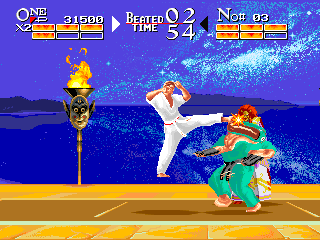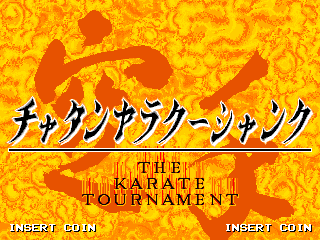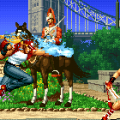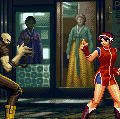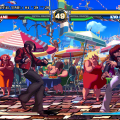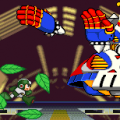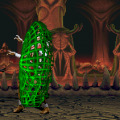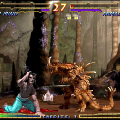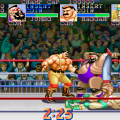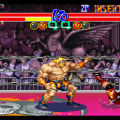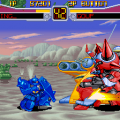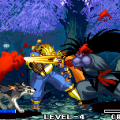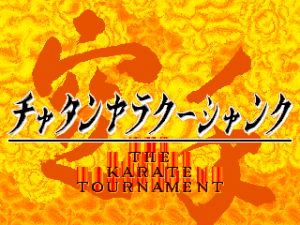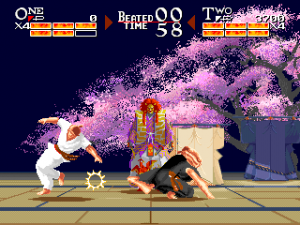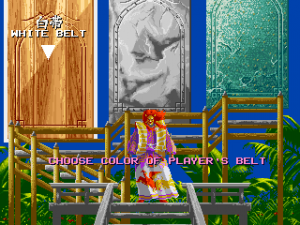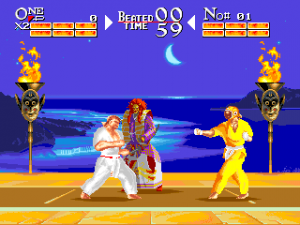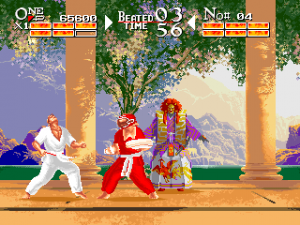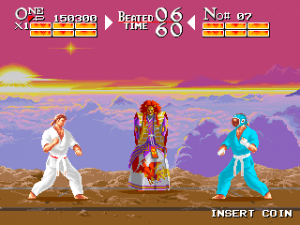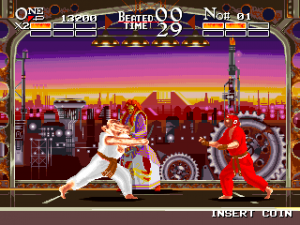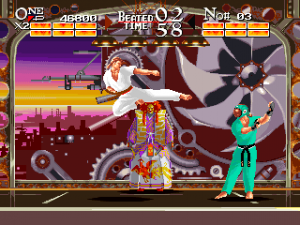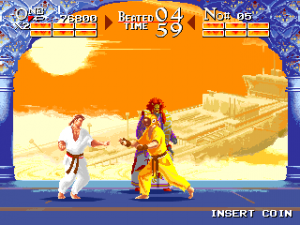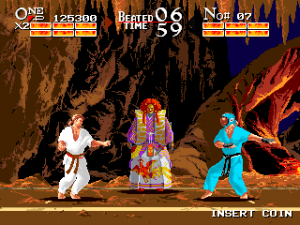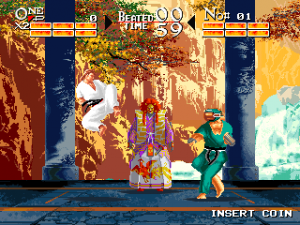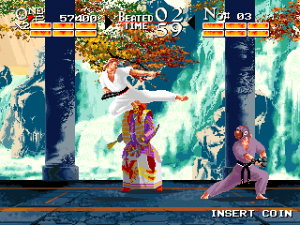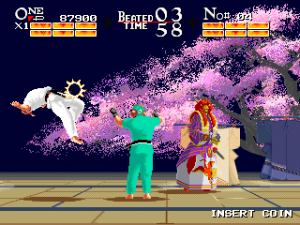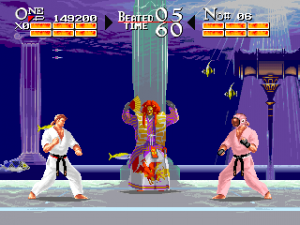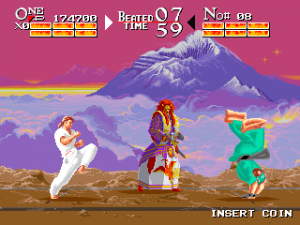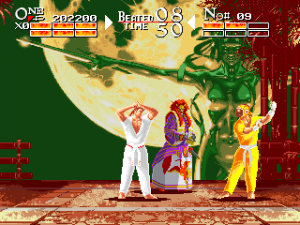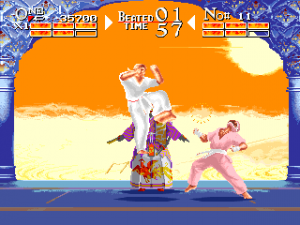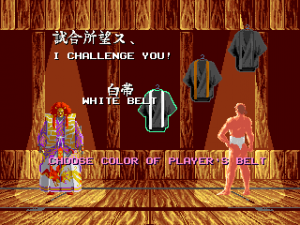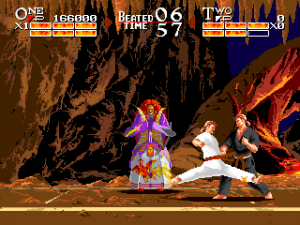1991 was indisputably THE year of the fighting game. That was when Street Fighter II revolutionized the genre worldwide, ushering in a new era for coin-op arcades that lasted for just about all of the nineties. Not only was Street Fighter II itself a smash hit, but several competitors rallying against it found great (though lesser compared to Street Fighter II) degrees of success. Mortal Kombat, King of Fighters, and Tekken are all names familiar to even modern gamers as those franchises continue to somehow live despite fighters having taken a nigh-hiatus after the early zeroes. While the rise, fall, and rebirth of fighting games is story perhaps worth its own documentary, it’s easy to forget that fighting games existed in various forms throughout the eighties.
The game that kickstarted the really early phase of the genre was Karate Champ (1984), developed by Technos of Kunio and Double Dragon fame, and published by Data East, who would later cut their slice of the pie with Fighter’s History (and run afoul of Capcom’s lawyers, but we digress). Before Street Fighter II made high jumps and ki projectiles the norm, Karate Champ was a more realistic portrayal of fighting competitions where striking the opponent earned you points, requiring two full points for victory. Konami’s Yie Ar Kung-Fu (1985) added the lifebar concept to the genre years before Street Fighter, with very few games from then on feeling like actual realistic tournaments judged by points. Yet there was at least one such game released a year after Street Fighter II, the closest thing Karate Champ ever got to a spiritual successor in 2D. Never having seen official light outside of Japan, its official title is Chatan Yarakuu Shanku, but they were nice enough to include the simple English alternate title of The Karate Tournament.
Curiously, The Karate Tournament was made by the Mitchell Corporation, the only known fighting game by what is essentially a splinter faction of Capcom, formed by several of its ex-employees. In fact, its project leader was Kouichi Yotsui, better known as Isuke, the creator of Strider, one of Capcom’s most beloved arcade hits. Isuke would go on to make Osman / Cannon Dancer, essentially his own non-infringing Strider game. In contrast, The Karate Tournamentdoes not feel like a clone of Street Fighter II, but it instead opts for a slightly (remember this modifier) more realistic take on fighters that hearkens back to Karate Champ. You play as a karateka with a white gi, or black if you’re player two. This is the only actual character you get, so if you’re spoiled by having at least six selectable fighters on the roster, you may not favor this game.
While you can’t be a green electrobeast or a stretchy yogi, you do have a diverse albeit simple moveset that simply depends on your joystick position. Standing still delivers a basic punch, holding forward performs a front kick, holding forward and down gives a sweep kick and so forth. There are nine quick attacks, each assigned to one direction of the eight-way joystick and one more for being neutral. There is also a jump button that allows you to hop forward, evasively backflip, or jump into the air from which you can jump kick. Each direction also has a “power attack” performed by pressing both buttons simultaneously, essentially doubling your movelist. These attacks can potentially knock your opponent out faster, but they have a delay which can ruin you if your opponent is prepared. This is why blocking is vital, where you automatically deflect high attacks by holding the joystick up, block low attacks with down, and parry mid-level attacks with left, right, or neutral.
Perhaps The Karate Tournament‘s most innovative factor is its “lifebar,” which is almost more akin to a negative form of Karate Champ‘s points system. Both contestants have six bars where one is taken away for a clean hit. However, if knocked down by both hits of a full power attack, a whopping three points are docked. Your points are regulated by the coolest aspect of the game, a referee clad in elaborate daimyo robes and a cool mask who shouts out whenever hits are made. The ref also stops the fight after a knockdown and resets both fighters to the center before resuming action; this is also done if either fighter moves to far to the stage’s edge, though no points are deducted for this. The fight’s over when someone loses all six points or the time runs out, where the winner has more points left.
The rules are pretty simple and the controls are pretty solid once you get used to them, but what gives The Karate Tournament its own feel is the art direction, both appealing and surrealist. Being that there’s only one base fighter sprite to animate, the karateka is fluidly animated with distinct motion blurs for several moves, looking nicer than the stiff sprites of its contemporaries. Not all of the moves are authentic karate, such as the ridiculous down-center power attack where your pelvis basically becomes a helicopter rotor, but most of the other attacks look quite graceful. Even more remarkable are the backgrounds, ranging from seaside arenas to mountains and caverns to a… factory with a creepy heartbeat for ambience? Some stages are pretty outlandish, like a dreamy cloudscape with two wrecked Japanese battleships juxtaposed in the background. A few backgrounds are vaguely predictive of Osman‘s visuals, including a temple that shows Isuke’s predilection for giant statues. Topping it is the intermission when you beat several computer opponents, where you ride a flying ship through a sea of fire while the referee dances crazily onboard. Nope, doesn’t make sense. Yup, pretty darn cool.
You’ll only get to see most of the backgrounds if you take on the computer, but The Karate Tournament is best played with two humans like any other fighter. Still, as a nice touch, all computer opponents get different gi colors and all wear headgear that obscures their face, and you do at least get three difficulty selections at the start. Admittedly, the game loses its flavor when played for too long since there isn’t a lot of variety to it, but that’s mostly the problem of the fighter genre’s growing scope and ambition. If you’re looking for something very unlike Street Fighter II and its ilk, The Karate Tournament not only exists as something cutting against the grain, but it also serves as a throwback to fighters of the eighties, something as a last hurrah before the Street Fighter II style almost entirely took over. It also looks dang good, and TKT at least does something different, automatically putting it above some of the less-inspired SF2 clones. Seriously, it’s a more interesting pick than, say, Shogun Warriors or Justice League Task Force. It’s better to be bold than bland!
Links:
The Large Cult Fighting Game March (In Japanese).
